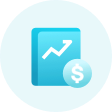TRUNG TÂM TRỢ GIÚP
FAQ about AscendEX futures trading
Đăng vào lúc 2024-04-09
Here is a collection of frequently asked questions about AscendEX futures trading for your reference:
1. What types of contracts does AscendEX support for futures trading?
AscendEX offers USDT-margined perpetual futures, where one or multiple cryptocurrencies can be used as collateral to trade various pairs such as BTCUSDT, ETHUSDT, and more. These contracts have no expiration date and are available for trading 24/7.
2. Which underlying assets can be traded in the futures market on AscendEX?
AscendEX currently supports nearly a hundred futures assets, and we will add more based on market conditions to meet our users’ needs. For detailed information on available futures trading pairs, you can directly visit the AscendEX futures trading section.
3. What is the Multi-Asset Collateral Mechaniam on AscendEX?
AscendEX introduces the Multi-Asset Collateral mechanism, which allows traders to use one or multiple cryptocurrencies as collateral for trading different futures pairs. To learn more, please read the Margin and Leverge.
4. Which underlying assets can be used as collateral for futures trading on AscendEX?
AscendEX perpetual futures supports the Multi-Asset Collateral mechanism. For the assets that can be used as collateral, please visit the Collateral Info page.
5. What are the cross margin and isolated margin modes?
In cross margin mode, all assets in the Futures account are used as collateral for opening positions. If the account is liquidated, the trader will lose all their assets. In isolated margin mode, only the assets required to open the current position are used as collateral. If the account is liquidated, only the collateral for the position (including added margin) under the isolated mode will be lost, while other futures positions remain unaffected. For more information on cross and isolated margin modes, you can refer to the Margin Mode: Cross/Isolated.
6. What position modes are supported for futures trading?
AscendEX Futures currently supports three position modes: One-Way, Hedge, and Multi-Position. For details on position modes, please the Position Mode: One-Way/Hedge/Multi-Position.
7. What types of orders are supported for futures trading?
AscendEX Futures offers four types of orders: limit orders, market orders, conditional orders, and trailing stop. For more information on order types, you can refer to the Futures Order Types. documentation.
8. What leverage is available in futures trading?
AscendEX offers leverage ranging from 1X to 200X for perpetual futures. Users can choose the desired leverage for futures trading based on their profit targets. The specific leverage options for each futures asset can be found on the futures trading page or the Contract Info page.
9. For the Multi-Asset Collateral mechanism, do non-stablecoin assets need to be discounted when used as collateral?
Yes, AscendEX’s Multi-Asset Collateral mechanism requires various discount rates when non-stablecoin assets are used as collateral for different underlying assets. For instance, if a user deposits 1 BTC with a current price of $70,000 as collateral in the Futures account, the collateral amount will be discounted based on a 98% margin discount rate for BTC, i.e. $68,600 for calculating the initial and maintenance margin rates. For more information on collateral discount rates for futures assets, you can access the Collateral Info page.
10. Can sub-accounts engage in futures trading?
Yes, sub-accounts can be used for futures trading.
11. Are there fees charged for futures trading?
Yes, fees are charged for futures trading on AscendEX. The trading fees are based on the trading fee schedule, which is 0.0400% for makers and 0.0600% for takers. AscendEX utilizes a tiered fee structure, where the VIP level is determined by the trading volume (denominated in USDT) and the average ASD holdings over the past 30 days. Higher VIP levels correspond to lower trading fees. You can lower your futures trading fees by increasing your VIP level.
12. How to check my current futures positions?
To check your current futures positions, you can view the information including open orders and trade history at the bottom of the futures trading page. You can also go to the Futures Orders > Open Order page to view position details.
13. How can I check my margin for my open futures positions?
You can go to the margin information section on the futures trading page to check your margin details.
14. How can I check the funding rate and payment records for futures trading?
You can go to the futures trading page for the corresponding trading pair and view the funding rate in the asset information section. To check the payment records for funding rates, you can visit the Orders > Futures Orders > Funding Payment page.
15. When the account is liquidated, will losses be shared if the balance is insufficient to cover them?
No, losses are only shared when the insurance fund is insufficient to cover the losses of a bankrupt account. The losses will be shared proportionally from accounts with unrealized profits. The sharing ratio is determined by taking the smaller value between 1 and the absolute value of (insurance fund deficit / sum of positive unrealized profits of accounts).
Note: The insurance fund will only be used to cover losses when a bankrupt account's position is liquidated at a price that is relatively worse than the mark price (i.e., for long positions, the liquidation price is higher than the mark price; for short positions, the liquidation price is lower than the mark price), and it is either taken over by BLPs or liquidated through automatic deleveraging of other accounts.














